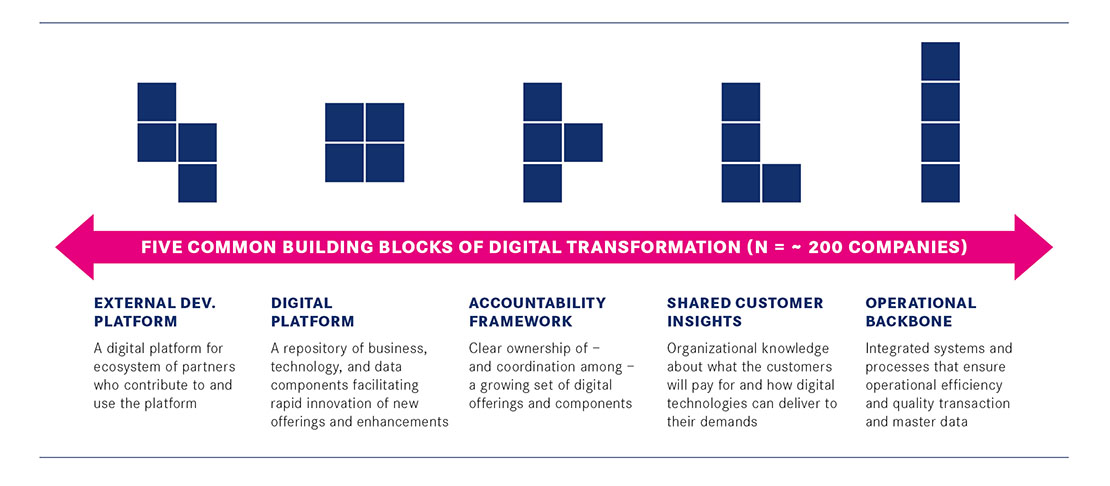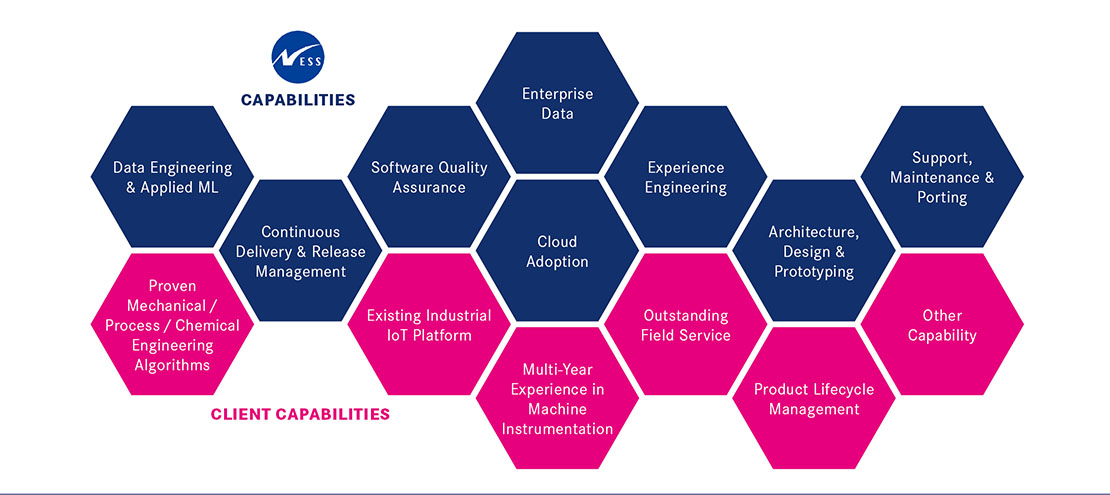
Ness Digital Engineering
Essential Elements
for Digital Transformation
Berthold Puchta
Global Industry Lead Manufacturing & Transportation, Ness Digital Engineering
The digital transformation of Industry is huge, the rate of change is accelerating and it is having a much broader economic and social impact than with the previous revolutions which were driven by steam and coal, electricity, and latterly computers. New architectures are emerging that can take advantage of the state-of-the-art in connected consumer electronics, unequalled global internet connectivity, efficient cloud compute and storage as well as swarm intelligence.
Designing for Digital
The digital transformation journey envisioned by many industrial players is an endurance marathon that can only be achieved with a phased approach. A common trajectory starts with (1) enhancing instrumentation, (2) digitizing remote monitoring of simple processes, (3) embedding basic automation with humans in the loop for support and corrective oversight, (4) applying machine learning and, eventually, (5) broadening AI-powered services to control the equipment with minimal human involvement.
This is the dream, but only part of the picture. Jeanne Ross et al. described in their 2019 book Designed for Digital 1 (MIT CISR), the digital platform as only one of five building blocks for a successful digital/data transformation in a sample of approximately 200 organizations. The others include the operational backbone (with its ERP, MES, and CRM), a shared understanding of the customer needs, an accountability framework, and, for the more advanced, an external developer platform to increase reach in the wider ecosystem. The accountability framework and governance mechanism drive the organization’s ability to scale the most successful initiatives and provide the foundation needed to turn them into enterprise-grade solutions.
The digital platform drives the need for several core capabilities that include cloud platform engineering, continuous software delivery at any scale (Ness refers to this as intelligent engineering), and edge software development for connected assets or data and analytics. The following examples provide additional context to the digital journey.
Cloud Platform Engineering
Our first example focuses on a leading map provider, who followed a typical path when moving geospatial data processing pipelines to the cloud. Their data products are used in over 100 million vehicles processing over 28 TB of collected data daily. Data processing at scale typically manifests in two forms of workload – batch and streaming. The cloud has greatly accelerated operations, and the adoption of container technology and container orchestration has further empowered teams with operational abstractions that resemble Aspect-oriented programming but for infrastructure. The sum of these yields greater agility and more frequent releases.
Ness gathered a similar experience in the intelligent transportation space by deploying an event-driven ticketing architecture in Asia. It leverages a scalable messaging broker to process events originating from the social network client LINE as well as public transport gates across the transport network. A cloud deployment accelerated the delivery and allowed the team to focus on distributed system challenges associated with event ordering.
Intelligent Engineering
In our second example, software product development adapted to meet accelerated demands in release cadence without sacrificing quality. Agile practices have entered the automotive industry under the name of adaptive agile to inject flexibility at the lower tip of the V-cycle under rigorous architecture oversight. Practices such as continuous integration or continuous delivery have complemented the ways of working for software teams across any industry.
Ness helped a leading enterprise content management software vendor boost its test coverage from 15% to 90% while reducing environment provisioning times from 8 hours down to 4 minutes. The overall cycle time for tests is now 4 days instead of 16. Automation and a balanced test pyramid are key to intelligent engineering of modern digital solutions.
Intelligent engineering has become even more important as the number of teams spanning across the overall product family grows. Coordination can only be achieved with practices such as Scaled Agile Framework, which cadences teams against a known release train and COVID-savvy town hall meetings.
Automation and common CI/CD pipelines help teams remain nimble and meet agility requirements. Such was the case for our customer, a large gas turbine manufacturer. The digital platform provides data from connected assets and supports processes along the entire lifecycle of the package from cradle to grave with 25 teams coordinated by 3 trains.
Edge Software Development
This brings us to our next topic, edge software development. Edge-side software in connected gas turbines has shifted the business model from selling the turbine itself to the energy it provides (often referred to as servitization – see Professor Andy Neely 2). The software stacks at the edge include constrained devices as well as concentrator or gateways powered by more advanced microcontrollers. This critical edge compute can also be found on consumer devices such as entertainment media boxes in hotel rooms, as well as automotive electronic control unites (ECUs).
One example where we combine intelligent engineering with tremendous advances in microcontrollers is active safety for a provider of radars, thermal night vision cameras, and advanced driver assistance and autonomous driving software. Work includes requirements engineering (with tagging of the Functional Safety ASIL level), design, coding (according to MISRA C/C++ ruleset), module, integration testing, and validation testing, in line with AUTOSAR 3.x / 4.x and SPICE norms. This allows our partner to ship their solution package including ECU, to a higher number of OEMs while ensuring adherence to the high development and validation standards of the automotive industry.
ECU development is also influenced by electrification and autonomous driving trends. Ness has witnessed this first-hand with an innovative Austrian partner for the development, integration, and testing of ECUs for the powertrain of electric vehicles. Similar to the previous example, Ness optimized processes and methods of software development.
Data & Analytics
Data and analytics are a fundamental part of the digital journey as organizations continue to generate increasing amounts of data and make new decisions about their optimal placement. Data governance remains an essential capability along with modern data processing techniques, including big data batch and stream processing or applied machine learning. Our partnership with a radiology imaging company led to the design and implementation of an end-to-end imaging data processing pipeline, including a data forge, a feature store and catalogue, a flexible data science sandbox, and finally, a systematic model-serving approach.
Cloud-based data processing can also accelerate the development cycle of a data product as was the case with ‘driving smoothness’ for our partner, a telematics service provider. This involved the processing of over 35 data attributes including GPS and data acquired via an on-board unit.
In the case of more advanced engineering applications involving structural computations, Ness leverages a distributed computing cluster to perform a solution search of systems of differential equations with parameters obtained through finite element analysis. This enterprise-grade architecture allows the organization to expose the calculation engine to turbine engineers across the enterprise who perform What-If analysis for their particular conditions.
Independent of novel data engineering and data science approaches, fundamental capabilities such as data governance, architecture, data strategy and road mapping, meta and master data management remain essential as critical decisions are delegated to algorithms and production data.
Capability Mix-ins
Ness is committed to cultivating innovation with an ecosystem of leading enterprise partners that complement our core strengths. As a result, Ness enjoys long-running and deep-standing relationships with our customers on the digital transformation journey.
Below are some examples of possibilities resulting from the new capabilities mix.
- Ability to manage hierarchies for tens of thousands of assets across multiple sites and roles.
- Compute remaining useful life computations with requisite integrations to enterprise applications and semantic data alignment.
- Edge-to-Cloud system testing involving multiple systems and communication paths & IoT protocols.
- Implementation of ML pipelines which let data engineers and data scientists collaborate on multiple experiments using various datasets with clear provenance.
- Ensure highest unit and functional test coverage of all platform components in automated fashion for shorter release cycles and greater customer satisfaction.
Digital technologies are evolving rapidly, providing a host of new opportunities for businesses to capitalize on the power of their data, create efficiencies, improve quality and performance, and drive profitable growth. Innovation is a never-ending process and Ness is committed to improving our understanding of these partners to provide ongoing value.
About Ness Digital Engineering
Ness is a digital solutions company with product engineering in our DNA backed by a global collective of software engineers, data experts, user experience designers and innovators. Combining core competence in engineering with the latest in digital technology, we build customer-facing platforms and software products that help businesses thrive in the digital economy. As your tech partner, we help engineer your company’s future with cloud and data. For more information, visit: www.ness.com.



